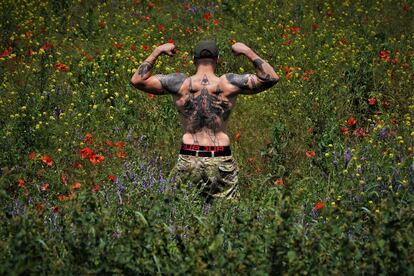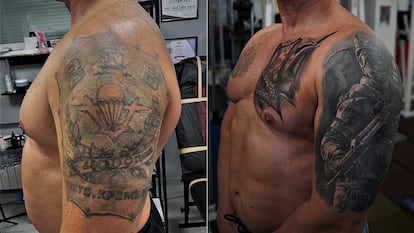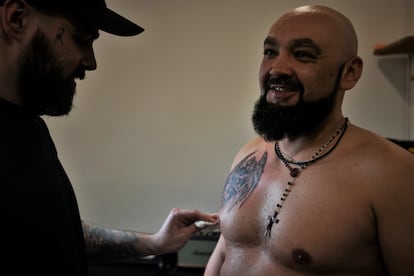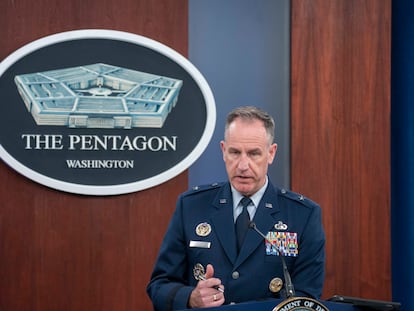War tattooed on Ukrainian skin: flags, missiles, and skulls
Military, patriotic, and commemorative designs are popular themes at Ukraine’s tattoo parlors

“Memento mori” (remember that you will die). This Latin phrase states the ephemeral nature of existence, but at the same time, it urges us to not to give up, to continue enjoying life. The phrase has become fashionable as a tattoo in Ukraine. 22-year-olds Veronika Kuznetsova and Marina Shevchenko found this out at the studio in Zaporizhia where they work. This city is the capital of one of the regions where the Ukrainian army is developing its counter-offensive against the Russians. Ukrainians have always worn ink on their skin, but the violence of war has prompted designs that highlight more pride in the homeland, death, military scenes, or even weapons. In some cases, the artform becomes means of commemoration, with the faces of loved ones forever accompanying those who lost them.
The two young women point out that one of the references to the conflict that they are most often asked to tattoo is also the shock experienced on Snake Island, seized by Kremlin troops on the first day of the invasion. There, according to a popular radio recording, the Russians asked the Ukrainians to surrender from their ship. One of the local guards shouted at them, “Russian ship, fuck you!” The image of a Ukrainian serviceman flipping off the enemy ship has become symbolic in the Ukrainian imagination. It appears on T-shirts, stamps, mugs ... And, indelibly, on the skin of many. On Saturday, the president himself, Volodymir Zelenski, released a video of his visit to the island to mark 500 days since his Russian counterpart, Vladimir Putin, launched the invasion on February 24, 2022.
But, if there is one skin that serves well to understand the relationship between Ukraine, tattoos and war, it is that of Roman Marchenko, a 53-year-old bodybuilding trainer. He was part of the Red Army between 1988 and 1990, in the death throes of the Soviet Union. “We were preparing to fight against NATO countries, like Spain and others. Now we want to belong to NATO,” he says with a laugh, recalling that period spent with his military colleagues in Mikolaiv, in the south of the country. Marchenko had a design tattooed on his left shoulder in honor of the famous Soviet paratrooper unit — today the Russian VDV — whose men were among the first to try, unsuccessfully, to take Kiev last year.
The bodybuilding trainer, built like a brick outhouse, sports other designs on his arms, chest and back and fought the invading army during 2022 as a member of the Ivan Bohun Brigade of the Kiev Special Forces. And what was he doing fighting the Russians with a tattoo that praises the VDV? Well, he asked himself the same question, but he could not find the time to erase what, over the years, has become a memory he considers inappropriate. Finally, this spring he found time to go to a studio in Zaporizhia, the city where he lives. “I no longer wanted to have remnants of the USSR on my body. I needed to forget all that and put it in the past,” he says. It was on April 24 when the sessions began to turn his life around with a new ink base.
The artist Julia Mas was responsible for making a new design of the former Soviet soldier, a task she describes as very difficult. But Marchenko’s story moved her. “He’s an interesting client,” says this near-forty-something designer who has been in the trade for a decade. The trainer now proudly looks like a battle-hardened member of the Ukrainian Special Forces equipped with all the latest equipment. There is nothing to suggest that the Red Army paratrooper remains underneath. Incidentally, a week before this report was made in June, the trident from the national coat of arms and the ears of corn representing Ukraine as one of the world’s granaries were added on his chest, just above the heart.

Mas acknowledges that the war spills over into her work on a daily basis. She was also struck by the tattoo she designed for a woman a few months ago, with the image of her husband, who had died in combat. Neither she nor another widow in the Kharkiv region who opted for another similar commemorative design wanted to speak to EL PAÍS. However, 30-year-old Sergey Semenov did. At the age of 21, he was a member of the Azov battalion and saw five comrades killed at a Russian military checkpoint outside Mariupol. In their memory, he has a huge multicolored tattoo on his left forearm, the base of which is a skeleton. In fact, his entire body is a rainbow of ink, as he shows after returning from the front.
Veronika Kuznetsova noticed among some of her clients in the Zaporizhia studio last year that there was a fear of tattooing motifs that might anger Russians, especially after the fall of Mariupol. When the Azovstal steel factory, the last bastion of resistance, was seized, images were broadcast of the invading military ordering prisoners to strip naked to supposedly check if they had Nazi motifs tattooed on their bodies — Moscow claims that it is occupying Ukraine to “denazify it.” Semenov knows the fighter who has neo-fascist tattoos and wonders as he defends the role they played in Azovstal, “Was the point of the victory at Mariupol to do away with them?”
Nastia Korol, a young woman who was training to be a soprano until the Russian invasion came, admits that acquaintances of hers have had tattoos erased that she considers “old patriotic symbols that the Russians consider to be Nazi. The same ones that [Russian company mercenaries] Wagner can also have,” she points out. Asked if they are Nazi symbols, she adds that she has some friends “with those tattoos, but they, of course, don’t advocate killing Jews.” “If Ukraine were racist we wouldn’t be supported by people of all kinds,” she adds. Korol, 24, is a volunteer paramedic on the front lines and expresses her feelings in the form of all monochrome tattoos. The story of the war, from that first Russian bombing that caught her in Kharkiv last year, is told using her body as a canvas. I remember that attack, a half-shark, half-missile design stands out. And it will continue, she adds, as long as the conflict lasts, and not forgetting the colleagues who have died.
The tattoos of the national flag with the blue and yellow, the ear of wheat, the map of Ukraine or the trident from the country’s coat of arms, are now joined by motifs more closely linked to the future of the war. This is the case of the sinking of the Moskva, the Russian flagship of the Black Sea Fleet that participated in the invasion of Snake Island, or the famous American-made Javelin anti-tank weapon. A huge allegory of what the Russian invasion means occupies the broad back of Oleksandr (he does not give his last name), a 30-year-old military man who is almost six feet five inches tall. He got a tattoo of a woman carrying a gun after witnessing the crimes committed by the Russians in towns such as Bucha and Makariv, in the Kiev region. As a result of those events, he decided not only to get a tattoo, but also to enlist. Today he fights on the Zaporizhia front.
As the invasion progressed, Roman Marchenko, the former Red Army man, was wounded in the right leg near Balakliia (Kharkiv region) by a 120-millimeter mortar shell. Eventually, he was forced to leave the army for health reasons between thromboses and lung injuries. During a visit to the gym where he works, he shows off some of the other tattoos he sports. On the right shoulder, a Jesus of Nazareth also survives from Soviet times. “Bless me and save me,” it reads. This religious drawing is a reminder of a time in his life that he is not particularly proud of. “I didn’t believe in God, but I needed to somehow get closer to him while I was part of a criminal group,” he says, referring to the extortion gang he was part of.

Three decades later, his life has been turned upside down. Married thee times, with two children and five grandchildren, Marchenko has embarked on a new path and decided to become a military chaplain. “Five years ago, I started to believe in God and during the war I realized that only he can save us,” the evangelical explains. After passing a series of courses, he has already started to wear the uniform again occasionally and to go to the front to give spiritual aid to the servicemen participating in the counteroffensive against the Russians in the Zaporizhia region.
Beyond these sporadic visits to the front, bodybuilding (he has been a judge in the discipline for more than two decades) is now at the center of his life. He recalls how the Russian invasion prevented him from attending the European Championships in Santa Susanna (Barcelona) in 2022. Martial law, which prevents men between the ages of 18 and 60 from leaving the country, still weighs heavily on him. Meanwhile, Marchenko remains convinced that he needs to remove any remnants of Soviet-era tattoos from his skin, such as the Christ, a tiger with a parachute adorning his back or the angel peeking out from his right breast. “I don’t need them,” he sums up, standing next to missile remnants and other war junk being auctioned off at the gym to raise money for the military and displayed next to a Christmas tree in the middle of summer.
Sign up for our weekly newsletter to get more English-language news coverage from EL PAÍS USA Edition
Tu suscripción se está usando en otro dispositivo
¿Quieres añadir otro usuario a tu suscripción?
Si continúas leyendo en este dispositivo, no se podrá leer en el otro.
FlechaTu suscripción se está usando en otro dispositivo y solo puedes acceder a EL PAÍS desde un dispositivo a la vez.
Si quieres compartir tu cuenta, cambia tu suscripción a la modalidad Premium, así podrás añadir otro usuario. Cada uno accederá con su propia cuenta de email, lo que os permitirá personalizar vuestra experiencia en EL PAÍS.
¿Tienes una suscripción de empresa? Accede aquí para contratar más cuentas.
En el caso de no saber quién está usando tu cuenta, te recomendamos cambiar tu contraseña aquí.
Si decides continuar compartiendo tu cuenta, este mensaje se mostrará en tu dispositivo y en el de la otra persona que está usando tu cuenta de forma indefinida, afectando a tu experiencia de lectura. Puedes consultar aquí los términos y condiciones de la suscripción digital.
More information
Archived In
Últimas noticias
Maduro pleads not guilty before the federal court in New York: ‘I am still the president of Venezuela’
A new test can detect Alzheimer’s from a finger prick
UN team enters Sudanese city of El Fasher after paramilitary massacre: ‘It’s like a ghost town’
A recipe for resistance: Indigenous peoples politicize their struggles from the kitchen
Most viewed
- Gilles Lipovetsky: ‘If you want to live better and fall in love, take Prozac, don’t look to philosophy’
- Alain Aspect, Nobel laureate in physics: ‘Einstein was so smart that he would have had to recognize quantum entanglement’
- Alvin Hellerstein, a 92-year-old judge appointed by Bill Clinton, to preside over Maduro’s trial in New York
- Why oil has been at the center of Venezuela-US conflicts for decades
- Cuba confirms death of 32 of its citizens in the US attack against Venezuela











































